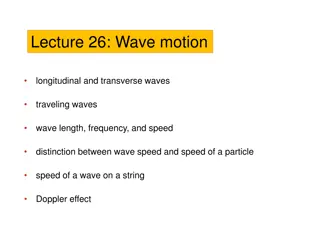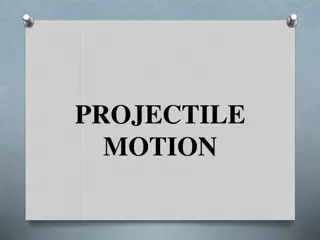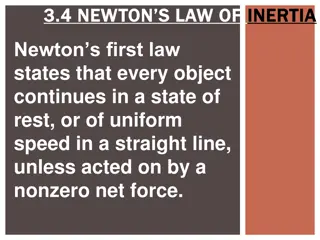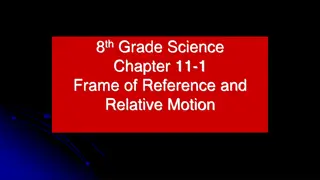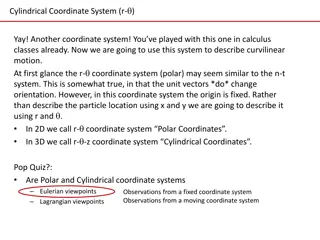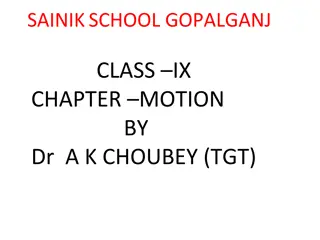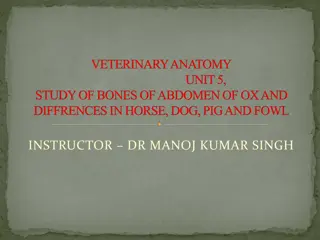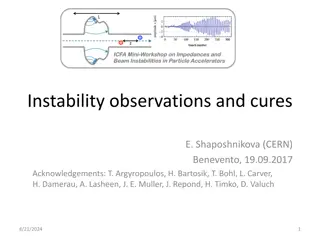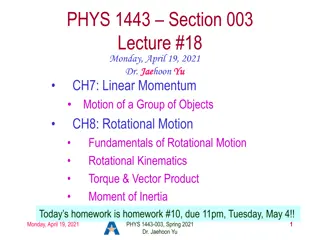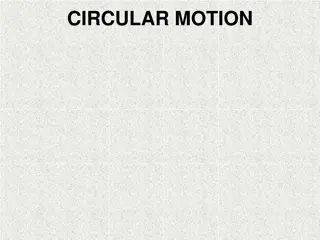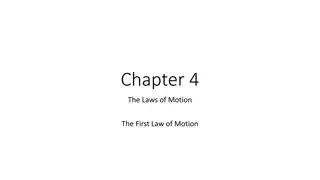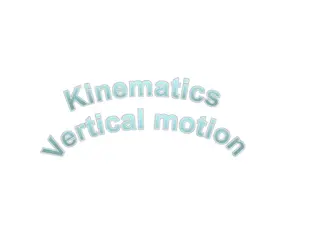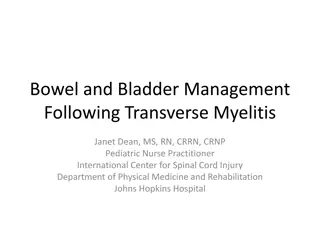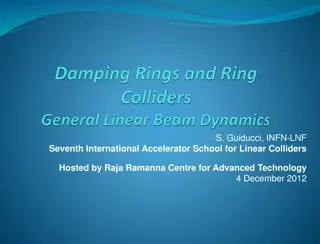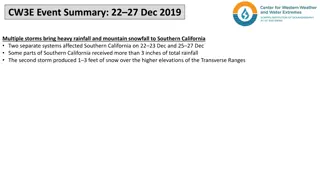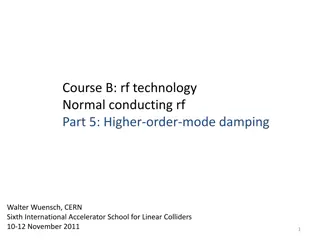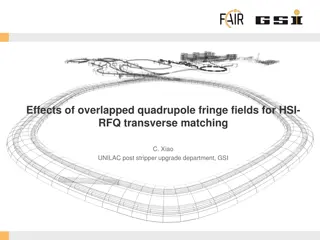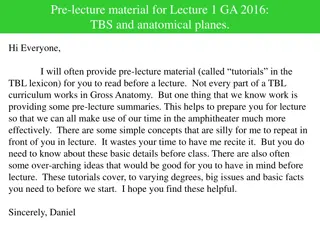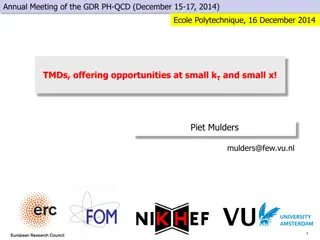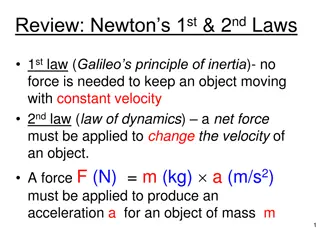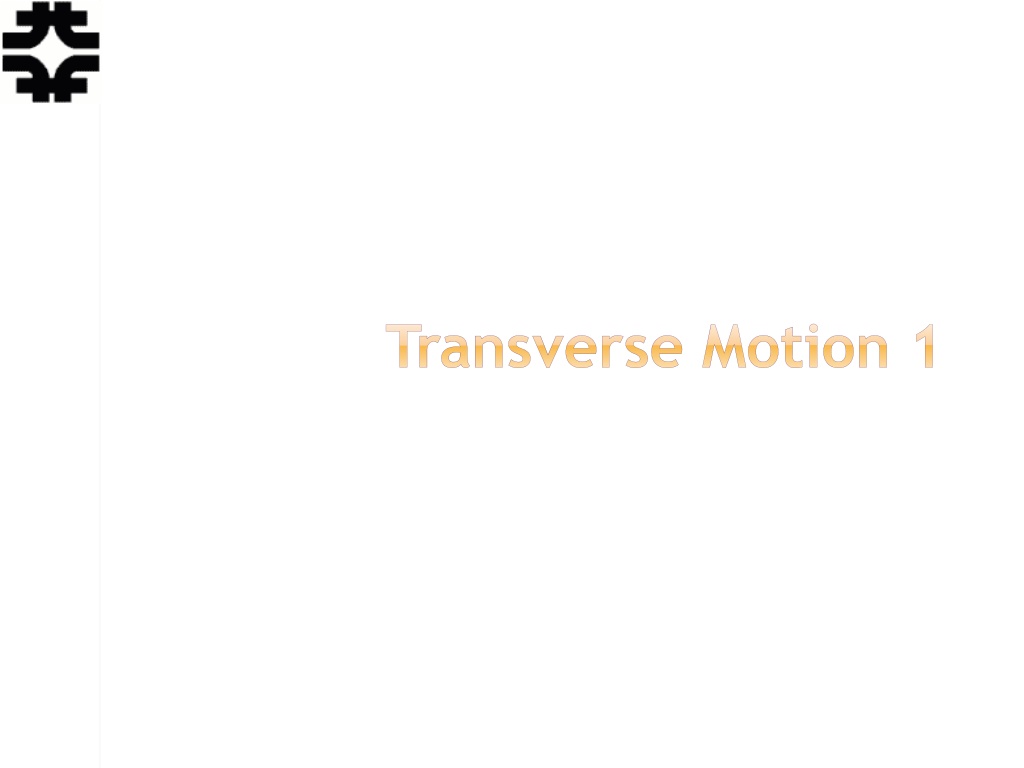
Understanding Transverse Motion in Accelerator Physics
Delve into the world of accelerator physics, where linear approximations and perturbations play a key role in understanding transverse motion. Explore concepts like quadrupole magnets, transfer matrices, and FODO cells to grasp the intricacies of beam dynamics.
Download Presentation

Please find below an Image/Link to download the presentation.
The content on the website is provided AS IS for your information and personal use only. It may not be sold, licensed, or shared on other websites without obtaining consent from the author. If you encounter any issues during the download, it is possible that the publisher has removed the file from their server.
You are allowed to download the files provided on this website for personal or commercial use, subject to the condition that they are used lawfully. All files are the property of their respective owners.
The content on the website is provided AS IS for your information and personal use only. It may not be sold, licensed, or shared on other websites without obtaining consent from the author.
E N D
Presentation Transcript
Transverse Motion 1 Eric Prebys, FNAL
The Journey Begins We will tackle accelerator physics the way we tackle most problems in classical physics ie, with 18thand 19thcentury mathematics! Calculate ideal equilibrium trajectory Use linear approximations for deviations from this trajectory Solve for motion Treat everything else as a perturbation to this As we discussed in our last lecture, the linear term in the expansion of the magnetic field is associated with the quadrupole, so let s start there Lecture 3 - Transverse Motion 1 USPAS, Knoxville, TN, Jan. 20-31, 2014 2
Quadrupole Magnets* B B x y y x A positive particle coming out of the page off center in the horizontal plane will experience a restoring kick lx ( ) Bx x l B = ( ) ( ) B B ( ) B = f ' B l *or quadrupole term in a gradient magnet 3 Lecture 3 - Transverse Motion 1 USPAS, Knoxville, TN, Jan. 20-31, 2014
What about the other plane? B x y ( ) B = f ' B l Defocusing! Luckily, if we place equal and opposite pairs of lenses, there will be a net focusing regardless of the order. pairs give net focusing in both planes -> FODO cell 4 Lecture 3 - Transverse Motion 1 USPAS, Knoxville, TN, Jan. 20-31, 2014
Transfer matrices The simplest magnetic lattice consists of quadrupoles and the spaces in between them (drifts). We can express each of these as a linear operation in phase space. Quadrupole: = ) 0 ( x x 1 0 ) 0 ( x x 1 f = 1 f 1 = ' ) 0 ( ' x ) 0 ( x x ' ) 0 ( ' x x Drift: = + ( ) s ) 0 ( x ) 0 ( ' sx ( ) 1 ) 0 ( x x s x s s = x = ( ' x ) ) 0 ( ' x ( ' x ) 0 1 ) 0 ( ' x s s By combining these elements, we can represent an arbitrarily complex ring or line as the product of matrices. M M N = M M ... 2 1 Lecture 3 - Transverse Motion 1 USPAS, Knoxville, TN, Jan. 20-31, 2014 5
Example: FODO cell At the heart of every beam line or ring is the FODO cell, consisting of a focusing and a defocusing element, separated by drifts: L L f -f The transfer matrix is then 2 2 L L L + 1 2 L 1 0 1 0 1 1 L 1 L 1 f f f 1 1 = = M + 1 1 0 0 L L f f + 1 2 f f Lecture 3 - Transverse Motion 1 USPAS, Knoxville, TN, Jan. 20-31, 2014 6
Where were going It might seem like we would start by looking at beam lines and them move on to rings, but it turns out that there is no unique treatment of a standalone beam line Depends implicitly in input beam parameters Therefore, we will initially solve for stable motion in a ring. Rings are generally periodic, made up of more or less identical cells In addition to simplifying the design, we ll see that periodicity is important to stability The simplest rings are made of dipoles and FODO cells Or combined function magnets which couple the two Our goal is to de-couple the problem into two parts The lattice : a mathematical description of the machine itself, based only on the magnetic fields, which is identical for each identical cell A mathematical description for the ensemble of particles circulating in the machine Periodic cell = = N cell M M M M M ring cell cell cell Lecture 3 - Transverse Motion 1 USPAS, Knoxville, TN, Jan. 20-31, 2014 7
Stability Criterion We can represent an arbitrarily complex ring as a combination of individual matrices M M n ring= M M M ... 3 2 1 We can express an arbitrary initial state as the sum of the eigenvectors of this matrix x + = x = + V V M V V A B A B 1 2 2 1 1 2 x x After n turns, we have x = + n n 1 n 2 M V V A B 1 2 x Because the individual matrices have unit determinants, the product must as well, so = / 1 1 2 Lecture 3 - Transverse Motion 1 USPAS, Knoxville, TN, Jan. 20-31, 2014 8
Stability Criteria (contd) We can therefore express the eigenvalues as where ; ; 2 1 e e = = a a general in is a complex However, if a has any real component, one of the solutions will grow exponentially, so the only stable values are ; 2 1 e e = = i i is where ; real Examining the (invariant) trace of the matrix Tr = e M i i + = 2 cos e So the general stability criterion is simply M ( ) abs Tr 2 Lecture 3 - Transverse Motion 1 USPAS, Knoxville, TN, Jan. 20-31, 2014 9
Example Recall our FODO cell 2 2 L L L + 1 2 L f f f = M L L L L + 1 2 f f f -f Our stability requirement becomes 2 L abs 2 2 2 L f f Lecture 3 - Transverse Motion 1 USPAS, Knoxville, TN, Jan. 20-31, 2014 10
Twiss Parametrization We can express the transfer matrix for one period as the sum of an identity matrix and a traceless matrix = + ) , ( s C s M 1 0 ( ) s ( ) s s s + A B 0 1 ( ) ( ) The requirement that Det(M)=1 implies + + = 2 2 2 ( ( ) ( ) ( )) 1 A B s s s We can already identify A=Tr(M)/2=cos . If we adopt the arbitrary normalization ) ( + s = 2 ( ) ( ) 1 s s We can identify B=sin and write 1 0 ( ) s ( ) s s s + = + + I J ( , ) cos sin cos sin M s C s 0 1 ( ) ( ) Note that 2 ( ) s ( ) s ( ) s ( ) s s s s s ( ) ( ) ( ) 0 s s s = = = 2 J I 2 ( ) ( ) ( ) ( ) 0 ( ) ( ) ( ) s s s + = J ( ) s M ( , ) s C s e So we can identify it with i=sqrt(-1) and write Remember this! We ll see it again in a few pages Lecture 3 - Transverse Motion 1 USPAS, Knoxville, TN, Jan. 20-31, 2014 11
Equations of Motion General equation of motion d p d = = = = F v e B m R m R dt dt x y s ( ( ) ) s v e B e e = = = + + x y R v v v 0 v B v B v B v B x y s s y s x x y y x m m m B B x y For the moment, we will consider motion in the horizontal (x) plane, with a reference trajectory established by the dipole fields. y s = + r x x Particle trajectory Reference trajectory Solving in this coordinate system, we have y y x r R = = + s = + + = + + R x r x r + y y + x r r 2 y y + ( ( ) ( ) x ) y y s = + + + = + + 2 s s s x R x r x r r + s 2 r r y y x r r r r y y ( ) + + 2 s r r r r Lecture 3 - Transverse Motion 1 USPAS, Knoxville, TN, Jan. 20-31, 2014 12
Equations of Motion (contd) Equating the x terms Note: s measured along nominal trajectory, vs measured along actual trajectory ev B = vs t r s y r = 2 r m 2 s ds 2 ev B ev B = = s y s y s sv = = r v s mv 2 p dt r s B y = ( ) B Re-express in terms of path length s. Use 2 2 2 v d ds d d d d = = = = ; s v v s s 2 2 dt dt ds r ds dt r ds r Rewrite equation 2 2 2 s v B r 2 v d r y = s v r ( v ) s B 2 ds r B 2 s 2 r r r y = + ( ) B y x 2 2 B (rearrange terms) 2 2 + + + B x x x y r = = + = 1 ; 1 x ( ) ( ) 2 B B + (use ) x Lecture 3 - Transverse Motion 1 USPAS, Knoxville, TN, Jan. 20-31, 2014 13
Equations of Motion Expand fields linearly about the nominal trajectory ( ) ( ) ( ) B s B s B s ( , 0 , 0 ) = + + coupling no ( , , ) x x x B x y s B s x y y x x x y y no dipole x ( ) ( ) ( ) ( ) ( ) B s B s B s B s B ( , 0 , 0 ) y y y y = + + coupling no + = + ( , , ) B x y s B s x y B x x 0 y y x y x x Plug into equations of motion and keep only linear terms in x and y ( ) ( ) B s B y + x 2 ( ) B s + + x 1 1 2 1 1 x x x y = + = + + 1 x x x ( ) ( ) 2 2 2 B B x Looks kinda like a harmonic oscillator ( ) B s 1 1 x y + + = 0 x ( B ) s 2 B x ( ) 1 y = 0 x y ( ) B y Lecture 3 - Transverse Motion 1 USPAS, Knoxville, TN, Jan. 20-31, 2014 14
Piecewise solution x + = ( ) 0 K s x These equations are in the form For K (gradient) constant), these equations are quite simple. For K>0, it s just a harmonic oscillator and we write ( s x ) ( ' = ) ( a ) ( ) cos = + = + ( ) cos cos sin x s A K s a K sin s b K s ( ) ( ) s + K K s K b x K 0 = = 0; a x b In terms if initial conditions, we identify and write K ( ) ( ) 1 K ( ) x x s cos sin K s K s 0 = ( ) ( ) 0 ( ) x x s sin cos K K s K s Lecture 3 - Transverse Motion 1 USPAS, Knoxville, TN, Jan. 20-31, 2014 15
For K<0, the solution becomes ( ) ( ) 1 K cosh sin K s K s ( ) x x s 0 = ( ) ( ) 0 ( ) x x s sin cosh K K s K s For K=0 (a drift ), the solution is simply ) ( s x 0 = x + x x s 0 ) ( 1 x s s 0 = 0 ( ) 0 1 x x s We can now express the transfer matrix of an arbitrarily complex beam line with M M M M 2 1 = M ... 3 n But there s a limit to what we can do with this Lecture 3 - Transverse Motion 1 USPAS, Knoxville, TN, Jan. 20-31, 2014 16
Closed Form Solution Our linear equations of motion are in the form of a Hill s Equation Consider only periodic systems at the moment ) + s assume + = + = ( ) ; 0 ( ) ( ) x K s x K s C K s ( = ( ) cos x s A K If K is a constant >0, then so try a solution of the form ( ) + = ) ( cos ) ( ) ( s s Aw s x + = ( ) ( BUT ), s w s C w s + ( ) ( ) s C If we plug this into the equation, we get ( = + w w A Kx x ( ) ( ) + + + + = 2 ) cos 2 ( A ) sin 0 Kw w w Coefficients must independently vanish, so the sin term gives ( ) k + = mutliply by + 2 = 2 = = 2 0 2 ' 0 ' w w w w w w 2 w w If we re-express our general solution ( ( 1 + = w A ) = A + w cos + w sin x w A A We ll see this much later 1 2 ) ( ) = k + w cos sin x A A w A w 2 2 1 k 2 k + cos sin A A w A + = 0 w Kw 1 2 2 1 w 3 w Lecture 3 - Transverse Motion 1 USPAS, Knoxville, TN, Jan. 20-31, 2014 17
Solving for periodic motion x Plug in initial condition (s=0 =0) = 0 A 1 w Define phase advances over one period ); ( sin C C S 0 x w x w = cos ( ) C 0 A 2 k and we have 0 k 2 x w x w w = + 0 ( ) x C x C S 2 0 w w w C S S 2 k k w w w 0 = + w C S x S x 2 0 ( ) x x C k k w w 0 + = 1 w 0 0 2 x w x w x k w w ( ) x k x C 0 + = + 0 0 ( ' x ) S C S C x C S 2 2 / k k k k w 2 k w w w = + + ' Sx C S x 0 2 w k k This form will make sense in a minute But wait! We ve seen this before Lecture 3 - Transverse Motion 1 USPAS, Knoxville, TN, Jan. 20-31, 2014 18
Recall the Twiss representation of a Period We showed a flew slides ago, that we could write 1 0 ( ) s ( ) s s s s + = + M ( , ) cos sin s C s sin 0 1 ( ) ( ) + ( ) s sin ) cos ( ) sin ( ) s = sin cos ( s 2 w We quickly identify = = ( ) s k (C ) 2 1 1 ( ) w w d w d s = = = ( ) s 2 2 k ds k ds Phase advance over one period + 2 1 ( ) s = ( ) s ( ) s We also showed some time ago that a requirement of the Hill s Equation was that C s w ) ( + s C 1 1 k 0 s = = = = ( ) ds 2 ( ) s Super important! Remember forever! 0 Lecture 3 - Transverse Motion 1 USPAS, Knoxville, TN, Jan. 20-31, 2014 19
Closing the Loop We ve got a general equation of motion in terms of initial conditions and a single betatron function (s) ) ( s x ds ( ) s 0 = + = ( ) cos ( ) ; ( ) A s s s ( ) s (s) is a parameter of the machine, but we still don t know its form! Important note! (s) (and therefore (s)and (s))are defined to have the periodicity of the machine! In general (s) (and therefore x(s)) DO NOT! Indeed, we ll see it s very bad if they do 1 1 ds ( Define tune as the number of pseudo-oscillations around the ring = N cell cell 2 2 ) s So far, we have used the lattice functions at a point s to propagate the particle to the same point in the next period of the machine. We now generalize this to transport the beam from one point to another, knowing only initial conditions and the lattice functions at both points ( ) 1 s s s = 1 d + ( ) ( ) cos ( ) x s A s s ds 1 ( ) ( ) s d s ( ) ( ) = + + ( ) cos ( ) ( ) sin ( ) x s A s A s s 2 ds ( ) s ( ( ) ( ) ) = + + + ( ) cos ( ) sin ( ) A s ( ) Lecture 3 - Transverse Motion 1 USPAS, Knoxville, TN, Jan. 20-31, 2014 20
We use this to define the trigonometric terms at the initial point as ( ) 0 x A 1 + = cos ( ) C s x 0 0 0 A A ( ) 0 + = 0 0 sin ( ) S s x 0 0 0 0 We can then use the sum angle formulas to define the trigonometric terms at any point (s1) as ( ) ( = cos 0 A ) + = + + = cos ( ) cos ( ) cos sin s C s C S 1 1 0 0 0 A A 1 0 + + 0 0 sin sin x x 0 0 ( ) ( ) + = + + = + sin ( ) sin ( ) cos sin s S s S C 1 1 0 0 0 A A 1 0 = 0 0 sin cos sin x x 0 A 0 0 Lecture 3 - Transverse Motion 1 USPAS, Knoxville, TN, Jan. 20-31, 2014 21
General Transfer Matrix We plug the previous angular identities for C1 and S1 into the general transport equations A x = ( ) + = cos A C 1 1 1 1 1 1 ( ) 1 = + x A C S 1 1 1 1 And (after a little tedious algebra) we find b1 b0 ( ) cosDy +a0sinDy b0b1sinDy = x1 x1 x0 x0 b0 b1 1 ( ) ( )cosDy - 1+a0a1 ( )sinDy ( ) a0-a1 cosDy -a1sinDy b0b1 This is a mess, but we ll often restrict ourselves to the extrema of , where cos sin 1 0 1 x x 0 1 = 0 d 1 0 1 = = x x 1 0 0 sin cos 2 ds 1 0 1 Lecture 3 - Transverse Motion 1 USPAS, Knoxville, TN, Jan. 20-31, 2014 22
About the Tune The tune is the number of oscillations that a particle makes around equilibrium in one orbit. For a round machine, we can approximate 2 1 1 ds R R = = 2 2 Note also that in general x y Lecture 3 - Transverse Motion 1 USPAS, Knoxville, TN, Jan. 20-31, 2014 23

